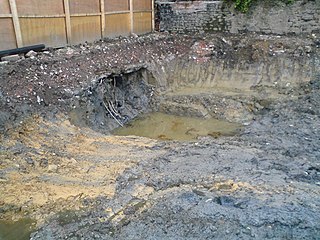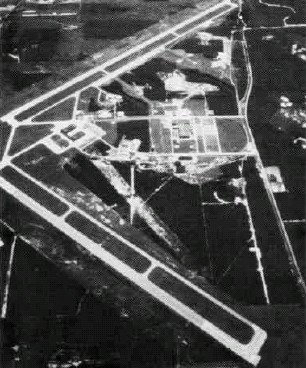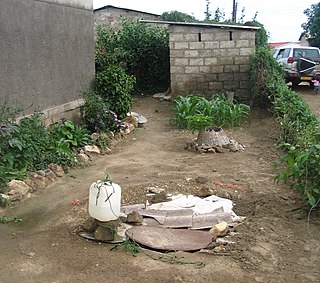
Environmental remediation deals with the removal of pollution or contaminants from environmental media such as soil, groundwater, sediment, or surface water. Remedial action is generally subject to an array of regulatory requirements, and may also be based on assessments of human health and ecological risks where no legislative standards exist, or where standards are advisory.

The Rocky Mountain Arsenal was a United States chemical weapons manufacturing center located in the Denver Metropolitan Area in Commerce City, Colorado. The site was completed December 1942, operated by the United States Army throughout the later 20th century and was controversial among local residents until its closure in 1992.

Soil contamination, soil pollution, or land pollution as a part of land degradation is caused by the presence of xenobiotic (human-made) chemicals or other alteration in the natural soil environment. It is typically caused by industrial activity, agricultural chemicals or improper disposal of waste. The most common chemicals involved are petroleum hydrocarbons, polynuclear aromatic hydrocarbons, solvents, pesticides, lead, and other heavy metals. Contamination is correlated with the degree of industrialization and intensity of chemical substance. The concern over soil contamination stems primarily from health risks, from direct contact with the contaminated soil, vapour from the contaminants, or from secondary contamination of water supplies within and underlying the soil. Mapping of contaminated soil sites and the resulting cleanups are time-consuming and expensive tasks, and require expertise in geology, hydrology, chemistry, computer modeling, and GIS in Environmental Contamination, as well as an appreciation of the history of industrial chemistry.
Vapor intrusion (VI) is a process by which chemicals in soil or groundwater - especially Volatile Organic Compounds (VOCs) - migrate to indoor air above a contaminated site.
AMCO Chemical was a chemical distribution company located in Oakland, California. The land the company operated on is designated as a U.S. Environmental Protection Agency (EPA) Superfund cleanup site.
Havertown Superfund is a 13-acre polluted groundwater site in Havertown, Pennsylvania contaminated by the dumping of industrial waste by National Wood Preservers from 1947 to 1991. The state first became aware of the pollution in 1962 and initiated legal action against the owners in 1973 to force them to cleanup the site. The Environmental Protection Agency (EPA) ranked the site the eighth worst cleanup project in the United States. The site was added to the National Priorities List in 1983 and designated as a Superfund cleanup site in the early 1990s. Remediation and monitoring efforts are ongoing and the EPA transferred control of the site to the Pennsylvania Department of Environmental Protection in 2013.
Groundwater remediation is the process that is used to treat polluted groundwater by removing the pollutants or converting them into harmless products. Groundwater is water present below the ground surface that saturates the pore space in the subsurface. Globally, between 25 per cent and 40 per cent of the world's drinking water is drawn from boreholes and dug wells. Groundwater is also used by farmers to irrigate crops and by industries to produce everyday goods. Most groundwater is clean, but groundwater can become polluted, or contaminated as a result of human activities or as a result of natural conditions.
Naval Weapons Industrial Reserve Plant, Bedford (NWIRP) was a government-owned, contractor-operated (GOCO) facility which had the mission of designing, fabricating, and testing prototype weapons and equipment from 1952 until December 2000, located in Bedford, Massachusetts It is located just north of Hanscom Air Force Base. It is currently a Superfund site undergoing environmental cleanup. NWIRP was divided into 4 sites, two in the northern section and two in the southern section.
The Omega Chemical Corporation was a refrigerant and solvent recycling company that operated from 1976 to 1991 in Whittier, California. Due to improper waste handling and removal, the soil and groundwater beneath the property became contaminated and the area is now referred to as the Omega Chemical Superfund Site. Cleanup of the site began in 1995 with the removal of hazardous waste receptacles and a multimillion-dollar soil vaporization detoxifying system.
The Del Amo Superfund Site is located in southern Los Angeles County between the cities of Torrance and Carson. It is a U.S. EPA Region 9 Superfund Site. The waste-disposal site of a rubber manufacturer is one of 94 Superfund Sites in California as of November 29, 2010.
The Oakdale Dump is an Environmental Protection Agency Superfund site located in Oakdale, Minnesota, and comprises three non-contiguous properties that were used for dumping from the late 1940s until the 1950s by the 3M corporation. The properties are named the Abresch, Brockman, and Eberle sites for their respective property owners at the time of disposal activities. The Abresch site is the largest of the three properties at about 55 acres. The Brockman site is located immediately southwest of the Abresch site and encompasses 5 acres. The Eberle site is located roughly 2,500 feet north of the Abresch site and encompasses 2 acres.
The FMC Corporation is a United States Environmental Protection Agency Superfund site of 18 acres (7.3 ha) in Anoka County, Minnesota, United States, several hundred feet east of the Mississippi River. Solvents, paint sludge, and plating wastes were generated and disposed of in an on-site dump from the 1940s until 1969. Minnesota Pollution Control Agency (MPCA) staff sampled site surface and groundwater in the early 1980s and confirmed that ground and surface water were contaminated by industrial solvents. In the 1980s, solvents from the site were detected in the city of Minneapolis drinking water system intake that is located downgradient of where the FMC site groundwater contaminant plume enters the river.

Naval Weapons Industrial Reserve Plant, Calverton (NWIRP) was a government-owned, contractor-operated (GOCO) facility which had the mission of designing, fabricating, and testing prototype aircraft from 1956 until 1996, in Riverhead, New York, United States.

Groundwater pollution occurs when pollutants are released to the ground and make their way into groundwater. This type of water pollution can also occur naturally due to the presence of a minor and unwanted constituent, contaminant, or impurity in the groundwater, in which case it is more likely referred to as contamination rather than pollution. Groundwater pollution can occur from on-site sanitation systems, landfill leachate, effluent from wastewater treatment plants, leaking sewers, petrol filling stations, hydraulic fracturing (fracking) or from over application of fertilizers in agriculture. Pollution can also occur from naturally occurring contaminants, such as arsenic or fluoride. Using polluted groundwater causes hazards to public health through poisoning or the spread of disease.
The A.O. Polymer manufacturing site is located in Sparta Township, New Jersey. This facility created special polymers, plastics, and resins. It was also used for reclaiming spent solvents. The facility's poor waste handling led to serious contamination of the ground. It also contaminated the water in the ground with volatile organic compounds. The site has been a threat to the Allentown aquifer, which provides drinking water to over 5,000 people. Initial clean ups started with getting rid of old drums and contaminants from their original disposal area. The company took them and decided to dispose of them elsewhere, thus not fixing the problem. Primary cleanups of the site were ongoing as of 2008. The EPA has been using water pumps to remove contaminants from the water in the ground. A soil extraction system has been put at their disposal to remove harmful contamination within the soil as well. All wells in the affected areas have been closed.
Emmell's Septic Landfill (ESL) is located at 128 Zurich Ave, Galloway Township, New Jersey and takes up about 38 acres of space. The landfill was in operation from 1967 until 1979. ESL disposed of liquid and solid waste including many chemicals such as volatile organic compounds (VOCs), Polychlorinated Biphenyls (PCBs), Trichloroethene and Vinyl chloride which all had their own effect on the environment and community. These chemicals affected the groundwater required millions of dollars to reconstruct the groundwater pathways and provide clean water to residents. The landfill holds a Hazardous Ranking Score of a 50/100, qualifying for the Superfund National Priority List. In August 1999, the state acknowledged the site's contamination and held town meetings and provided research upon the site such as groundwater samples. In July 1997, a sitewide investigation was called upon by the United States Environmental Protection Agency. In total the clean up was estimated to cost $5 million to fund this superfund site, and a grant of $3.9 million was given by the Federal Government under the Recovery Act Funding (Previti). Today, the project is still ongoing however, greatly improved since the landfill was discovered.
Brook Industrial Park (BIP) is an industrial area occupying 4.5 acres of the Borough of Bound Brook, New Jersey, in the United States of America. It is located on the northern bank of the Raritan River. Industrial, chemical and pesticide operations began in 1971 and eventually lead to the contamination of groundwater and exposure of workers to harmful dioxins. Throughout 1980 to 1988 the United States Environmental Protection Agency (EPA) and the New Jersey Department of Environmental Protection (NJDEP) conducted studies to determine if there were any threats being posed on the workers, community or environment by the BIP companies in their disposal of processed and stored chemicals.
The Orange Valley Regional Groundwater Superfund site is a group of wells in Orange and West Orange, two municipalities in Essex County, New Jersey, United States. The groundwater in the public wells are contaminated with the hazardous chemicals of Trichloroethylene (TCE), Dichloroethene (DCE), Tetrachloroethylene (Perchloroethene), 1,1-Dichloroethene (1,1-DCE), and 1,2-Dichloroethene (1,2-DCE). These chemicals pose a huge risk to the towns nearby population, as the wells are a source of public drinking water. In March 2012, the site was added to the National Priorities List (NPL) of the United States Environmental Protection Agency (EPA) Superfund site list.
Thermo-Chem, Inc., also referred to as Thermo-Chem, is a 50-acre Superfund site located in Egelston Township near Muskegon, Michigan.
The G&H Industrial Landfill is a Superfund site located in Shelby Charter Township near Utica, Michigan. The 60-acre (24-hectare) landfill, with about 10 to 20 acres of adjacent property, operated as a waste oil recovery facility from 1955 to 1967. From 1955 to 1974 the site was used as an industrial and municipal landfill. Contaminated soil, surface water, and groundwater with hazardous chemicals have been left behind as a result of the disposal of waste solvents, waste oil and paint sludge. Operation and maintenance activities are ongoing following the cleanup.





